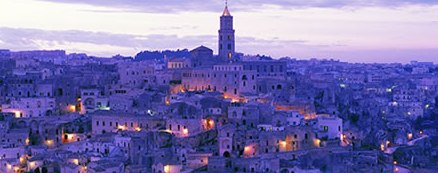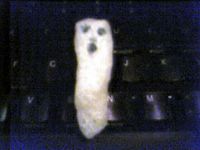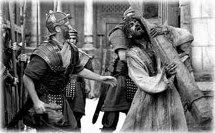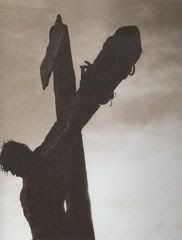Matera to double as ancient Jerusalem
Matera Journal
It's Not Jesus' Jerusalem, but as a Stand-In It's Safer
By FRANK BRUNI

MATERA, Italy, Nov. 5-The gates of old Jerusalem rise high and pale yellow above the millenniums-old dwellings here, and the door to the room of the Last Supper is almost as easily spotted, thanks to a padlock that keeps the curious at bay.
But the precise location of Jesus' dying moments is trickier to pinpoint, and as Serafino Paternoster searched for it this afternoon, he tried to spot signs of the cross.
Should he heed the scattered red paint marks in the scrubby, wild grass?
Or the metal screw, perhaps an anchor for something heavy, that poked out of the flinty, chalky soil?
"Maybe this is where the crucifixion is," Mr. Paternoster said as he bent down to examine the shiny object. He was sure he was getting close.
A stickler might point out that he was more than a bit off course-in the wrong part of the world, in fact.
But if Mr. Paternoster and other residents of this remote southern Italian city seem at times to lose sight of that distinction, it is understandable. A succession of moviemakers have convinced them that Matera is almost as much like biblical environs as anything in the turbulent Middle East: a headache-free Holy Land.
Mel Gibson is here now, using the craggy landscape and rudimentary stone dwellings, known as "sassi," as sets for "The Passion," a movie he is directing about the last 12 hours in Jesus' life. The tour that Mr. Paternoster provided was of various locations, structures and props for the film.
But Mr. Gibson is not the first to divine something biblical in Matera. In the early 1960's, the Italian director Pier Paolo Pasolini shot "The Gospel According to St. Matthew" here. In the mid-1980's, the American actor Richard Gere came to Matera to play the title role in " King David."
So when Mr. Gibson swooped down early this month with a crew of hundreds, no one here was the least bit surprised.
"There's a lot in common with old Jerusalem," sald Mayor Michele Porcari, who conceded that he had not actually seen Jerusalem, at least outside of movies. But, he added, "the sassi are like one would imagine Jerusalem would be."
By now, Matera's residents are well versed in the clues that the Bible is coming to life. Facial hair sprouts more copiously than it usually does, as the local men hired as extras try to get in sync with a less barbered era.
"During 'King David,' everybody wore a beard," said Nicola B.anco, 37, a waiter at Trattoria Lucana where Mr. Gibson has eaten several meals. "They asked people to grow them out, and now they're doing it again."
Tattered wool robes, dirty rags and ratty sandals have made a fashion comeback. At the movie set early this evening, dozens of people were dressed that way, like refugees from a low-rent Christmas pageant.
Several of them took note of the chill in the air and complained that biblical garb was not terribly insulating. Even so, they brimmed with excitement.
Ferdinando Irene, 29 a local salesman, stretched out his right arm as he delivered the heady news that he was in the running to be a "hand double" for the crucified Jesus.
"They saw my hand," Mr. Irene said, examining it with newfound respect, "and they just called me over. They even took photos."
Some of the stone dwellings in the old part of Matera, a farming and furniture-making city of about 55,000 people in the arch of Italy's boot, date back to before Jesus's time. They are more or less carved from the limestone of a steep slope on one side of a deep gorge, and their pale beige hue is not unlike that of Jerusalem stone.
The Rev. Jerome Murphy-O'Connor, authorof "The Holy Land: an Archaeological Guide," said that although he had never visited Matera, it was probably a perfectly suitable stand-in for old Jerusalem, which he said was not all that difficult to replicate.
"If you have stone buildings of one story with flat roofs, then you're in Jerusalem," sald Father Murphy O'Connor, who lives and works there.
Because of the danger, he said, few biblical movies are actually shot in Jerusalem. One that he sald did a pitch-perfect job of evoking the landscape was "The Gospel According to St. Matthew."
Told that it was made in Matera, he exclaimed, "The countryside looked quite similar to here!"
For Mr. Gibson, who is strongly Catholic, verisimilitude was important. He is shooting "The Passion," which stars the actor James Caviezel as Jesus, in ancient Aramaic, and has said he hopes the visual and visceral power of the story will mean that he will not have to add subtitles.
That archaic idiom has challenged some of the 1,500 Matera residents working as extras.
"When Jesus passes, we say-what do we say?" Vincenzo Gatta, 35, a nursing home attendant, asked a fellow extra. " Something like, 'Ala mamma my my.' Something like that."
"It's not like we're speaking it the whole day," Mr. Gatta sald. "Plus, I've taken a little French and English."
He was at a loss to explain what, exactly, was so biblical about Matera. So were other residents.
The mayor sald there was surely something special about the quálity of the Mediterranean light here, although he noted that the same light had attracted directors who used Matera as a substitute for Spain and northern Africa. Since Matera turns out to be something of a cinematic Rorschach, local officials want to start a commission to attract more filmmakers.
A man renting a house to Mr. Caviezel sald that what Matera had was a preternatural sense of quiet, a spiritual intensity.
Adriano Farinola, l9, had a simpler hypothesis. "These rocks are really old," he said.





